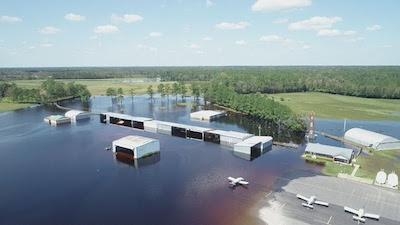An Estimated 100 Missions Have Already Been Completed In The Region
The U.S. Department of Transportation’s Federal Aviation Administration (FAA) has issued 46 special waivers for drone operations to support emergency and recovery efforts since Hurricane Florence made landfall. More than a dozen drone operators have flown an estimated 100 drone missions related to the storm under existing Part 107 authorization.

The FAA granted the waivers on an expedited basis under a “Special Governmental Interest” process for drone operators to fly response missions, which provide crucial benefits to the public good and address critical circumstances.
Examples of these response missions include:
- Firefighting
- Search and Rescue
- Law Enforcement
- Utility or Other Critical Infrastructure Restoration
- Incident Awareness and Analysis
- Damage Assessments Supporting Disaster Recovery Related Insurance Claims
- Media Coverage Providing Crucial Information to the Public.
The FAA also quickly turned on the agency’s Low Altitude Authorization and Notification Capability (LAANC). LAANC provides access to controlled airspace surrounding airports through near real-time processing of airspace authorizations below approved altitudes. For example, Wilson County, NC, emergency responders were among the first to use drones for search, rescue and recovery activities. In addition, major utilities are using drones to inspect power lines and insurance companies are conducting damage assessments.
Also, NCDOT is using the FAA’s Drone Pilot Program technology to support its drone inspection teams.
The North Carolina Department of Transportation – one of 10 Lead Participants in the Unmanned Aircraft Systems Integration Pilot Program – is using airspace monitoring technology it acquired as part of that program to track operations of its 15 drone teams conducting bridge, highway, and dam and waterway inspections in Florence’s wake. It is also using the AirMap technology to monitor and message all other drone operators in the state that have filed flight plans with AirMap, on the latest news and restrictions in real time.
The AirMap technology uses FAA air traffic information to monitor manned aircraft operations, such as law enforcement, search and rescue and media flights. It also enables NCDOT officials to keep track of its own drones and to re-deploy them to other locations, as necessary. Since Tuesday, the NCDOT drone teams have conducted 76 operations and expect to conduct many more flights today and through the rest of the week.
Finally, FAA experts are in both North Carolina and South Carolina Emergency Operations facilities. The FAA team is working with state and local authorities, as well as utility and insurance businesses, to ensure overall coordination among parties and efficiently process waiver requests.
In May 2018, the Department launched the UAS Integration Pilot Program to test the safe operation of drones in a variety of conditions that are currently prohibited. These include operations over people, beyond the line of sight, and at night. The goal is the safe integration of drones into our national airspace.
Secretary Chao talked about the importance of the Pilot Program at this year’s sixth Annual Commercial Aviation Industry Summit on September 12th. "There are exciting new technologies on the horizon that have the potential to transform transportation as we know it today. That’s why in May 2018, the Department launched a pilot program to test the safe operation of drones in a variety of conditions that are currently prohibited. These include operations over people, beyond the line of sight, and at night. The goal is the safe integration of drones into our national airspace."
(Image provided with FAA news release)
 Bolen Gives Congress a Rare Thumbs-Up
Bolen Gives Congress a Rare Thumbs-Up The SportPlane Resource Guide RETURNS!!!!
The SportPlane Resource Guide RETURNS!!!! Buying Sprees Continue: Textron eAviation Takes On Amazilia Aerospace
Buying Sprees Continue: Textron eAviation Takes On Amazilia Aerospace Hawker 4000 Bizjets Gain Nav System, Data Link STC
Hawker 4000 Bizjets Gain Nav System, Data Link STC Echodyne Gets BVLOS Waiver for AiRanger Aircraft
Echodyne Gets BVLOS Waiver for AiRanger Aircraft



